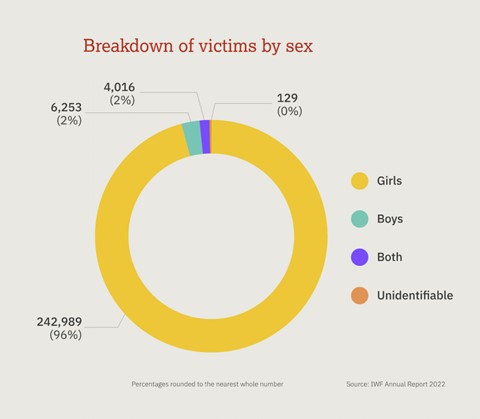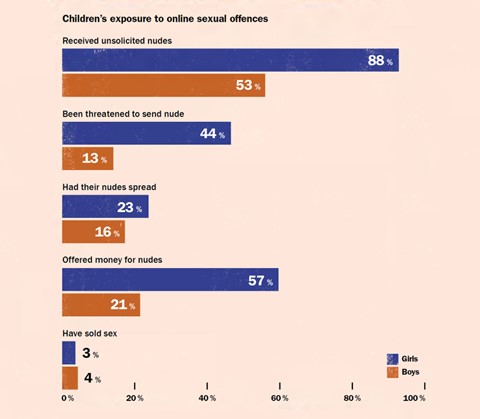Since 2012, the United Nations International Day of the Girl has been celebrated on 11 October. The child rights organisation and Plan International co-initiated this day and set a focus topic every year with the Girls' Report. In 2023, the topic will be "Her Body, Her Choice", focusing on girls' physical and mental health concerning sexuality and reproduction. On World Girls' Day, klicksafe asks: What about girls' sexual self-determination on the internet?

Sexism on social media
Children and young people need space for experimentation as part of healthy personality development. Who am I? What do I like? And how do I appear to others? Social media offers the opportunity to explore this. It opens access to other life realms, connections and communities.
However, girls are confronted with (everyday day) sexism in social media, which can hinder the free development of their entire personality. They are reduced to their appearance and devalued if they do not conform to conservative role stereotypes. Their bodies are judged without being asked. In comment sections, girls can witness the condescension and abuse women are subjected to.
In this way, gender-based power relations are also maintained online, and rigid gender stereotypes are codified. Girls learn that sexism is socially accepted and adopt unequal treatment into their understanding of roles and values.
Digital sexual violence
Social media are also used for sexual harassment and violence. Often, minors are unexpectedly confronted with sexual allusions and expectations in the comments sections. They are put under pressure in livestreams by being promised gifts and likes if they follow sexual instructions. And when there is the option to send direct messages, this function is abused to send girls nude photos without being asked.
Direct messages also play a crucial role in cyber grooming. Once the public is excluded, girls are encouraged to send intimate pictures or videos of themselves. Or they are asked to perform sexual acts on themselves in front of a running camera. This can lead to blackmail aimed at obtaining further recordings. Or a face-to-face meeting may be arranged to continue the abuse outside the internet.
The German Police Crime Statistics (PKS) recorded 48,821 reported cases of production, possession or distribution of child and youth pornographic material in Germany in 2022 (+10 per cent compared to the previous year). The international figures are also alarming to the 2022 Internet Watch Foundation annual report (IWF). Most of the children depicted are between 11 and 13 years old. But there is a 13 per cent increase in the age group of 7 to 10, compared to the previous year. Age is decreasing while the severity of abuse is increasing. One thing the IWF statistics show consistently when comparing the last three years is that images of girls make up the absolute majority of abuse depictions online (2022: 96 per cent).
A Swedish study conducted in 2021 with more than 13,000 participants aged 10 to 17 also found significant differences between the sexes. For example, 88 per cent of girls surveyed said they received nude photos without being asked (53 per cent of boys), and 57 per cent of the girls surveyed had already been offered money for nude photos.
 Image 1: From the Internet Watch Foundation's 2022 Annual Report.
Image 1: From the Internet Watch Foundation's 2022 Annual Report.
 Image 2: From the Swedish study "Everything that is not a yes is a no" (2021)
Image 2: From the Swedish study "Everything that is not a yes is a no" (2021)
Sexual violence is a massive violation of a person's integrity. Fear, helplessness, feelings of powerlessness, self-doubt and social isolation can result. Depending on the severity, frequency and relationship between the victim and the perpetrator, children and young people may suffer serious psychological or physical consequences. In the case of digital sexual violence, the consequences are further exacerbated because those affected cannot be sure where the depictions of abuse were published and who has access to them. Even if incriminating material is successfully removed from a platform, victims are not protected from further dissemination (re-victimisation).
What can we do to prevent this?
As parents, educators, and friends, we need to support girls in learning effective protective mechanisms. Prohibitions are of little help: if the girls have bad experiences, fear and shame prevent open discussion and access to help.
We can empower and support girls by:
- Providing them with positive online resources that enable them to develop a healthy relationship with their bodies and sexuality,
- teaching them that sexual violence on the internet is punishable and how to recognise signs of cyber grooming,
- agree with them on ground rules for contact with strangers,
- educate them about the risks associated with sexting,
- enable them to use the reporting, blocking, and help systems of social media services,
- talk to them about the dangers associated with different ways of interacting with social media services,
- and set a good example by speaking out against sexist behaviour online.
Find out more about the work of the German Safer Internet Centre, including their awareness raising, helpline, hotline and youth participation services – or find similar information for other Safer Internet Centres throughout Europe.
Since 2012, the United Nations International Day of the Girl has been celebrated on 11 October. The child rights organisation and Plan International co-initiated this day and set a focus topic every year with the Girls' Report. In 2023, the topic will be "Her Body, Her Choice", focusing on girls' physical and mental health concerning sexuality and reproduction. On World Girls' Day, klicksafe asks: What about girls' sexual self-determination on the internet?

Sexism on social media
Children and young people need space for experimentation as part of healthy personality development. Who am I? What do I like? And how do I appear to others? Social media offers the opportunity to explore this. It opens access to other life realms, connections and communities.
However, girls are confronted with (everyday day) sexism in social media, which can hinder the free development of their entire personality. They are reduced to their appearance and devalued if they do not conform to conservative role stereotypes. Their bodies are judged without being asked. In comment sections, girls can witness the condescension and abuse women are subjected to.
In this way, gender-based power relations are also maintained online, and rigid gender stereotypes are codified. Girls learn that sexism is socially accepted and adopt unequal treatment into their understanding of roles and values.
Digital sexual violence
Social media are also used for sexual harassment and violence. Often, minors are unexpectedly confronted with sexual allusions and expectations in the comments sections. They are put under pressure in livestreams by being promised gifts and likes if they follow sexual instructions. And when there is the option to send direct messages, this function is abused to send girls nude photos without being asked.
Direct messages also play a crucial role in cyber grooming. Once the public is excluded, girls are encouraged to send intimate pictures or videos of themselves. Or they are asked to perform sexual acts on themselves in front of a running camera. This can lead to blackmail aimed at obtaining further recordings. Or a face-to-face meeting may be arranged to continue the abuse outside the internet.
The German Police Crime Statistics (PKS) recorded 48,821 reported cases of production, possession or distribution of child and youth pornographic material in Germany in 2022 (+10 per cent compared to the previous year). The international figures are also alarming to the 2022 Internet Watch Foundation annual report (IWF). Most of the children depicted are between 11 and 13 years old. But there is a 13 per cent increase in the age group of 7 to 10, compared to the previous year. Age is decreasing while the severity of abuse is increasing. One thing the IWF statistics show consistently when comparing the last three years is that images of girls make up the absolute majority of abuse depictions online (2022: 96 per cent).
A Swedish study conducted in 2021 with more than 13,000 participants aged 10 to 17 also found significant differences between the sexes. For example, 88 per cent of girls surveyed said they received nude photos without being asked (53 per cent of boys), and 57 per cent of the girls surveyed had already been offered money for nude photos.
 Image 1: From the Internet Watch Foundation's 2022 Annual Report.
Image 1: From the Internet Watch Foundation's 2022 Annual Report.
 Image 2: From the Swedish study "Everything that is not a yes is a no" (2021)
Image 2: From the Swedish study "Everything that is not a yes is a no" (2021)
Sexual violence is a massive violation of a person's integrity. Fear, helplessness, feelings of powerlessness, self-doubt and social isolation can result. Depending on the severity, frequency and relationship between the victim and the perpetrator, children and young people may suffer serious psychological or physical consequences. In the case of digital sexual violence, the consequences are further exacerbated because those affected cannot be sure where the depictions of abuse were published and who has access to them. Even if incriminating material is successfully removed from a platform, victims are not protected from further dissemination (re-victimisation).
What can we do to prevent this?
As parents, educators, and friends, we need to support girls in learning effective protective mechanisms. Prohibitions are of little help: if the girls have bad experiences, fear and shame prevent open discussion and access to help.
We can empower and support girls by:
- Providing them with positive online resources that enable them to develop a healthy relationship with their bodies and sexuality,
- teaching them that sexual violence on the internet is punishable and how to recognise signs of cyber grooming,
- agree with them on ground rules for contact with strangers,
- educate them about the risks associated with sexting,
- enable them to use the reporting, blocking, and help systems of social media services,
- talk to them about the dangers associated with different ways of interacting with social media services,
- and set a good example by speaking out against sexist behaviour online.
Find out more about the work of the German Safer Internet Centre, including their awareness raising, helpline, hotline and youth participation services – or find similar information for other Safer Internet Centres throughout Europe.
- < Previous article
- Next article >












